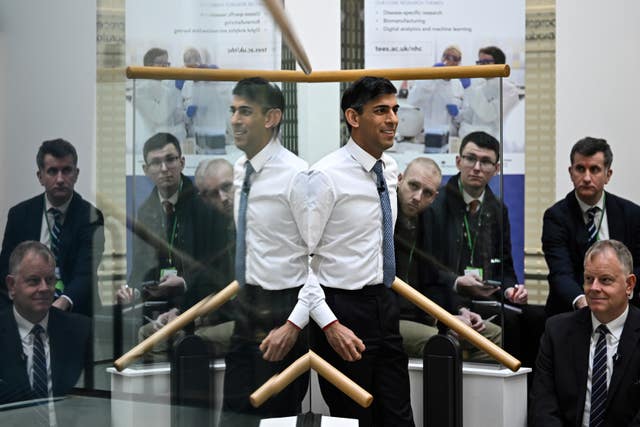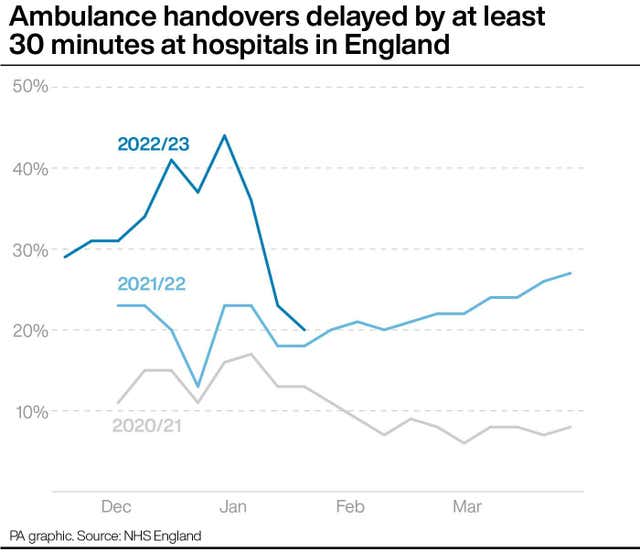Emergency care plan cannot ignore staffing and funding, Sunak warned
Rishi Sunak said his Government had an ‘ambitious and credible plan’ to fix emergency and urgent care in England.

The scale of the challenge facing the NHS will not be fixed without tackling funding and staffing, the Government has been warned, as it prepares to publish a plan to boost under-strain emergency care.
Promises of thousands more hospital beds and 800 new ambulances are at the centre of a new plan that the Government hopes will boost urgent and emergency care, after a difficult winter dominated by grim warnings about the severe pressure facing the NHS.
Announcing the two-year plan for England, the NHS and Government said 800 new ambulances, including 100 specialist mental health vehicles, and 5,000 more sustainable hospital beds would be backed by a dedicated £1 billion fund.
A major element of the strategy is to expand urgent care in the community, keeping people away from under-strain hospitals and seeing them treated at home.
It will see same-day emergency care units, staffed by consultants and nurses, open in every hospital with a major A&E.
Ministers hope that measure will see thousands of people each week avoiding an overnight stay in hospital.

But he also said that it would be the next long-term workforce plan for the NHS that would likely be the real defining document for the health service.
“Whatever service you’re looking at, the one thing that’s going to affect quality of care and access is the number of staff you have so unless you’ve got a clear proposal for that as part of this plan, it’s hard to see how it will have an impact very quickly,” he told the PA news agency.
Mr Anandaciva also questioned the timeframe for the two-year blueprint.
“It’s plan that’s tied to a political cycle,” he said.
“This isn’t a plan that says ‘here’s how things are going get better tomorrow’. It’s much more medium-term than that. So it’s not meeting the service right now.
“Neither is it some sort of big expansive vision for where the service is going in the future. So it’s not a vision document for the next five to 10 years of how this investment is going to change the experience of patients.”

Mr Sunak, who has made cutting waiting times in the NHS one of his five priorities as Prime Minister, said: “Urgent and emergency care is facing serious challenges but we have an ambitious and credible plan to fix it.
“It will take time to get there but our plan will cut long waiting times by increasing the number of ambulances, staff and beds – stopping the bottlenecks outside A&E and making sure patients are seen and discharged quickly.”
The plan comes as Mr Sunak’s Government is locked in a bitter and ongoing dispute with nurses and ambulance workers over pay and conditions, with further walkouts planned for February.
Patricia Marquis, the Royal College of Nursing’s director for England, said: “More hospital beds and more community and social care services are desperately needed to ensure patients get the right care in the right place at the right time.
“But the real problem is the lack of staff. Extra beds are only safe when there are enough nurses for the patients in them. And because of the workforce crisis, existing services are unsafe.”

It comes as health officials increasingly look to virtual wards as part of the solution to combat NHS pressures. These see patients treated from home while monitored by medics either through daily visits or video calls.
Health Secretary Steve Barclay, writing in the Daily Telegraph, warned that “fixing our NHS is no mean task”.
Suggesting that he would like to see greater transparency in the health service, he wrote: “I want NHS managers and the wider public to have access to the same facts from the front line, starting with publishing the number of 12-hour waits from the time of arrival in A&E from April.”
He also says that he wants to “hold true to that promise of an NHS that is always there for us”.

There will also be efforts to expand the number of emergency medical technicians, alongside greater use of student and apprentice paramedics, as well as training more staff in mental health.
“The NHS has been under more pressure than I have ever known in my 25 years working in the service,” NHS chief executive Amanda Pritchard said, adding that officials will shortly set out its workforce plan.
Ministers want to ensure that 76% of A&E patients are seen within four hours by next March, while category two ambulance response times – such as suspected strokes, heart attacks, burns and epilepsy – get to an average of 30 minutes over the next year.
Matthew Taylor, chief executive of the NHS Confederation, called it an “important road-map”, but warned that success would “depend on NHS staff continuing to go above and beyond, but also on concerted action to reduce the numbers of people needing to come into contact with emergency and urgent care services in the first place.”
Dr Adrian Boyle, president of the Royal College of Emergency Medicine, welcomed most the proposals, but warned that “the implementation and results are what really matter”.
Wes Streeting, Labour’s shadow health secretary, dismissed the initial details of the plan.
“Now Rishi Sunak is watering down standards for patients. Even if the NHS achieves his targets, patients will be left waiting longer than is safe,” he said.
“Expecting the Conservatives to fix the crisis in the NHS is like expecting an arsonist to put out the fire they started, it is just not going to happen.”





